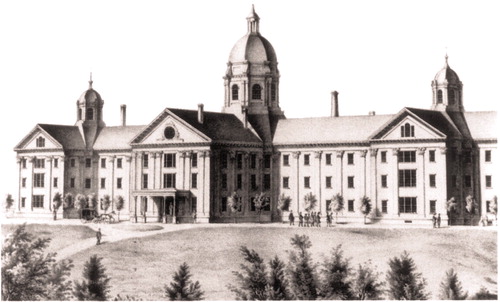Taunton State Hospital, Massachusetts
Deinstitutionalization has not shuttered some of the earliest psychiatric hospitals in America. Eastern State Hospital, near Williamsburg, Va., was the first asylum established on American shores and is still operating with modern methods of treatment and rehabilitation of the seriously mentally ill (1). Another early hospital, completed in 1853, the second in Massachusetts, is still functioning in Taunton, where it has been reinvented for specialized, intensive services for mentally disabled, forensic patients.
Taunton State Hospital was constructed on rural farmland in the Georgian style on a monumental scale and is an exemplar of classical revival, institutional architecture. Elbridge Boyden, the most prominent New England architect of the mid-19th century, designed Taunton with domes, capitals, and cornices made of cast iron, his signature construction material, to fulfill the dual roles of function and decoration. Boyden situated the three-story hospital “on a gentle eminence, at the extreme northerly part of the farm, being about one mile from town.” The dome’s cupola, rising 70 feet above the roof, offered a “panoramic view of great beauty, embracing the neighboring town, with its many tokens of busy life, numerous ponds and streams with which the surrounding country abounds, and reaching even to the blue hills of Norfolk County.”
The building boasted all of the conveniences of the time: central heating, running water, sewerage, and central ventilation. It contained a chapel, kitchen, bakery, laundry, dining rooms, apartments for staff, open-air verandas, and dormitory and individual rooms for patients (who were no longer referred to as “inmates”). The hospital continues to serve the people of southeastern Massachusetts today and includes a wide variety of planned and scheduled rehabilitation and recreational activities, including skills training (2), that are available days and evenings, seven days a week. Staff members have the cultural competence with which to serve individuals with Portuguese, Hispanic, African American, and Asian American backgrounds. Training and internship programs for students in medicine, occupational therapy, psychology, nursing, and social work are linked with Harvard Medical School and local colleges.
Address reprint requests to Ms. Musgrave, Taunton State Hospital, 60 Hodges Ave. Ext., Taunton, MA 02780; [email protected] (e-mail).

Taunton State Hospital
1. Dhillon AS, Dollieslager LP: Overcoming barriers to individualized psychosocial rehabilitation in an acute treatment unit of a state hospital. Psychiatr Serv 2000; 51:313–317Link, Google Scholar
2. Wallace CJ, Liberman RP, Kopelowicz A: Psychiatric rehabilitation, in Treatments of Psychiatric Disorders, 3rd ed. Edited by Gabbard GO. Washington, DC, American Psychiatric Publishing, 2001, pp 1093–1112Google Scholar



